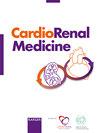更简单有效的微型化床旁超滤设备的理由和需求。
IF 2.4
4区 医学
Q2 CARDIAC & CARDIOVASCULAR SYSTEMS
引用次数: 0
摘要
在不同的急性或慢性临床情况下,体液超负荷都会导致不良后果。使用限制性策略控制体液或使用利尿剂往往效果不佳,因此需要体外超滤来清除过多的体液。这些体外治疗需要使用笨重的机器,并需要高度专业的人员。制造一种用于体外超滤(人工利尿)的微型设备将填补这一领域的技术空白,满足成本控制和病人康复的需要。在这篇文章中,我们将解释设计这种设备的基本原理。本文章由计算机程序翻译,如有差异,请以英文原文为准。
Rationale and Need for Simpler and Effective Miniaturized Bedside Ultrafiltration Devices.
Fluid overload in different acute or chronic clinical settings results in unfavorable outcomes. The use of restrictive strategies for fluid control or the use of diuretics is frequently ineffective and requires extracorporeal ultrafiltration for the removal of excess volume. These extracorporeal treatments are performed with bulky machinery and require highly specialized personnel. The creation of a miniaturized device for extracorporeal ultrafiltration (artificial diuresis) would fill the technological gap in this sector by responding to the needs of cost containment and rehabilitation of the patient. In this article, we explain the rationale that led to the design of this device.
求助全文
通过发布文献求助,成功后即可免费获取论文全文。
去求助
来源期刊

Cardiorenal Medicine
CARDIAC & CARDIOVASCULAR SYSTEMS-UROLOGY & NEPHROLOGY
CiteScore
5.40
自引率
2.60%
发文量
25
审稿时长
>12 weeks
期刊介绍:
The journal ''Cardiorenal Medicine'' explores the mechanisms by which obesity and other metabolic abnormalities promote the pathogenesis and progression of heart and kidney disease (cardiorenal metabolic syndrome). It provides an interdisciplinary platform for the advancement of research and clinical practice, focussing on translational issues.
 求助内容:
求助内容: 应助结果提醒方式:
应助结果提醒方式:


